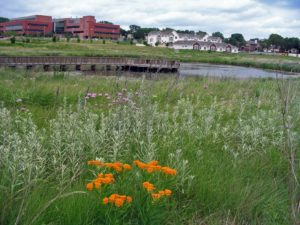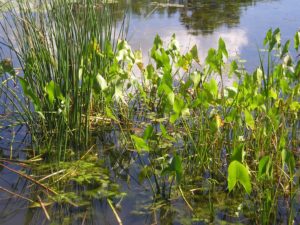
A Lake Mirrors the Past, Present and Future
By Sage Passi
Yesterday, the old people and kids carried arm fulls of trash – everything from car hoods and pipes, algae-covered shopping carts to glass and plastic bottles up to the parking lot overlooking Ames Lake. Ames Lake Journal April 2000
A story I wrote twenty years ago called Ames Lake Journal recently emerged like this glistening time-piece on the east side of St. Paul that resurfaced at the turn of the twentieth century. In 2000, the waters of this re-birthed wetland in our watershed were clearer back then. Through the daily pocket camera snapshots she shot through the holes in the construction fence, Dorothy Lynch, an energetic eighty year old RSVP volunteer who lived in an apartment building across the street captured the metamorphosis of Ames Lake from its scarred teenager-hood as a misplaced shopping center to its reemergence as a glistening wetland garden She told me she could hear the gurgling of the spring fed waters returning to see the light of day from her open living room window.
Marian Seabold recalled the day in the early 1960’s when she awoke to heavy smoke in the air. The peat in the wetland was on fire and the smoke hung in the air for weeks. Soon dump trucks filled in the wetland to prepare for the building of Phalen Shopping Center with the expectation that a major highway would be routed nearby. But that road was never built. Eventually Phalen Center’s shelf life would come to an end. Ames Lake Journal April 2000
These transformations were captured in the quilt squares that the Across Generations elders and Farnsworth fifth graders crafted as they stitched together the story of Ames Lake.
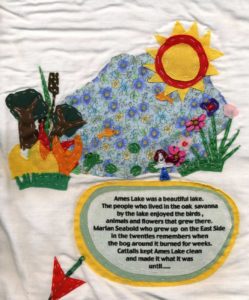


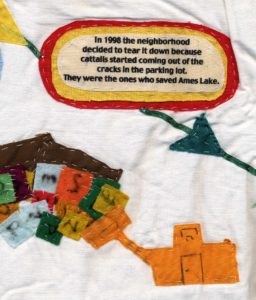
It was the spring of 2000 and Marian Seabold’s dream was coming true. As a young girl living on the east side of St. Paul, she had grown up witnessing the sights and sounds of this once vibrant home for songbirds, spring peepers and chorus frogs that she would stop to listen to on her path between her home near this spring-fed wildflower-laden pond and the streetcar stop on her way to downtown St. Paul
Now, as a Retired and Senior Volunteer Program member, she was joining in with the other jubilant voices of her Across Generations teammates in shouting, “Ames Lake is back!” For many years, Marian Seabold and Dorothy Lynch would share their memories with kids and the rest of us on the boardwalk at Ames Lake.
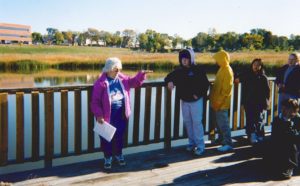

Phalen Shopping Center was constructed in an old glacial river valley of the St. Croix River which flowed south from Lake Phalen to the Mississippi River. During the last glaciation, gravels and soils were deposited in the valley and large chunks of ice were left in low areas, forming Lake Phalen and the Phalen Chain of Lake to the north. The glaciers left a landscape of rolling, well drained land dotted with lakes (including Ames Lake), and other ponds and wetlands that remained on poorly drained soils deposited in low areas. This area provided fish and wildlife habitat and was (and is still today) along a major flyway for migrating waterfowl and songbirds. This geological background “paved” the way for Ames Lake’s eventual return.

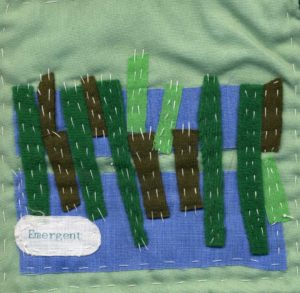
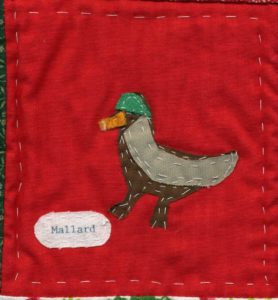
I’ve heard stories from many sources that set the stage for Ames Lake’s rebirth. Over time, some of the buildings on the former site of Ames Lake were often flooded and gradually sunk. The parking lot buckled in many places and cattails sprouted up between the cracks in the pavement. Ginny Newman, a St. Paul Community Education Service Learning Specialist who grew up in the neighborhood, recalled that she and her boyfriend in high school loved to race together in his car through the Phalen Shopping Center parking lot, bouncing over the speed bumps created by these “cattail” disruptions in the blacktop.
Cathy Troendle, an RWMWD teaching consultant who used to live close by, described her experiences at the shopping center. “The Canadian geese and mallards would gather in the water at the end of the parking lot where it was deep enough for them to paddle. I didn’t realize at the time that this was their ancestral stopping grounds along their flyway between the Mississippi River and the lakes to the north.”
In February this year, I was preparing L’Etoile du Nord School fourth graders for a winter field trip to Ames Lake by sharing some history about the area. A substitute teacher for that day joined in on the discussion and described how she had been involved in a neighborhood task force working on the Phalen Corridor Initiative, a related road project that coincided with the removal of the shopping center.
“In some places, during the excavation in the Phalen parking lot, they found blacktop layered 10 feet deep!” she exclaimed.
As a part of the City Comprehensive Plan process in the mid-1990’s, the City of St. Paul and a neighborhood-based task force contemplated strategies to transform this rapidly declining area into a more stable, viable and livable community. The negative image of this largely vacant shopping center and the impacts on the neighborhood identity called for some serious brainstorming. Sherri Buss, a University of Minnesota Landscape Architecture graduate student who was involved in the task force proposed reopening the lake to tie the area to Phalen Lake and Park, enhance surrounding property values and help attract commercial and residential development. Many people in the neighborhood resonated with these ideas.
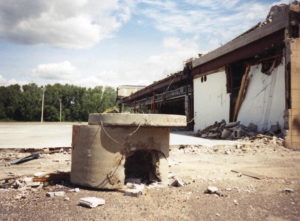
Professor Joan Nassauer, a nationally recognized expert in achieving biodiversity and ecological success in restored wetlands from the Department of Landscape Architecture at the University of Minnesota finished the conceptual design for rebuilding the lake and the wetland surrounding it. A grant for $650,000 from the Metropolitan Council was secured for purchasing the site. The Legislative Commission on Minnesota Resources (LCCMR) provided $600,000 toward the project. Ramsey-Washington Metro Watershed District contributed $500,000 and the Metropolitan Commission offered an additional $100,000 toward the restoration of the lake and wetland park.
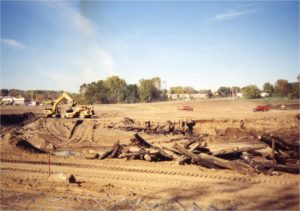
Excavation of Ames Lake began in the spring of 1998. Underneath the sandy soil that had been used for fill when the shopping center was built, lay the original wetland soil. This material was excavated and stockpiled on the site. Later it was pulverized and placed on the restored lake. After the excavation, groundwater began to seep back into the bed of the lake. Several weeks later the water in Ames Lake was about five feet deep. The site was left dormant for a year, providing time to monitor the water elevations to determine the emergent, wet meadow and mesic prairie planting zones. Source: A Chinese Journal, Nature and Man, “Ames Lake Reverses.” November and December 2005,
Perhaps this explains why some of the native aquatic vegetation returned such as native water millfoil and even though it was not planted there during the restoration. The seed bank was still there after all those years!
In May, the plants will return to their rightful home. Elders and young people are waiting to see this dream come true. It’s a blessing to participate in this journey of investigation and collaboration with plants. I take my orders from the plants now. I know that things will begin to change then, because plants are allies to humans and their healing powers can work miracles. Ames Lake Journal April 2000
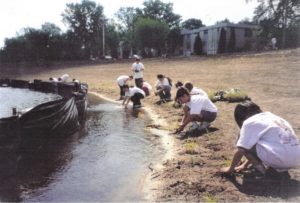
In 2000, when I worked for Eco Education, I organized hundreds of students who helped plant many of the 25,000 seedlings that were installed along the water’s edge in the wet meadow, the mesic and the upland prairies around Ames Lake. North American Prairies Company was responsible for implementing this large scale planting and seeding and continued to do follow-up maintenance on the site until this role was transferred to the city of St. Paul five years later. Farnsworth students wrote grants to develop interpretive signs, designed T-shirts and murals. Together with Across Generations elders, they crafted a quilt called a “pandau” which translates into Hmong as “cloth made beautiful like a flower.” This collectively produced fabric art illustrated the history of Ames Lake and its return, telling the story of the elders, children and the plants that brought it back to life.
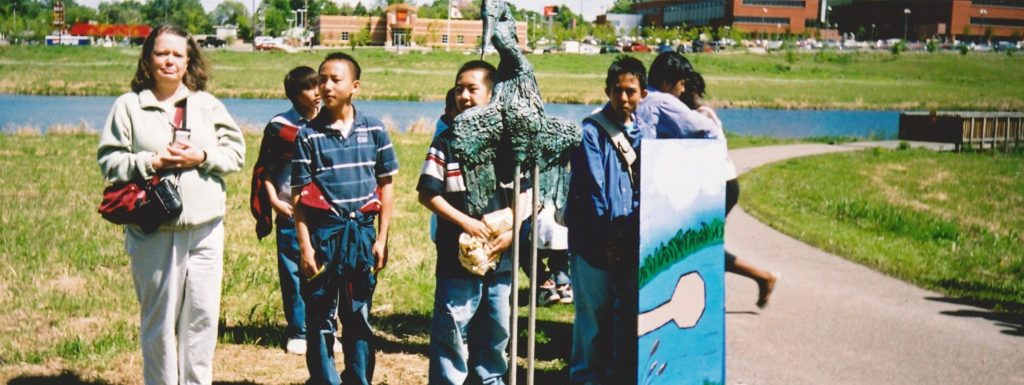
For eight years Cleveland Quality Middle School’s eighth grade teams formed teams to study and monitor the wetland and it ecological transformation. They interacted with the community surrounding it, met with leaders and residents in the area, created art, designed and installed a heron sculpture near the lake and provided neighborhood education about this first-in-the nation project. Their water quality teams kept logs of the data they collected through their years of observation and testing. The Ames Lake project became a nationally significant model for urban wetland restoration that demonstrated how to achieve biodiversity and provided valuable environmental educational opportunities for the community.
The neighborhood has embraced this return of the lake. To this day they use it for nature walks, bird-watching and fishing. They bring their lunches over to sit on the benches during their breaks. Seniors from a high-rise across the street help in clean-ups and residents from the nearby townhomes and apartments walk over to the park to enjoy its diversity of plants and birds. When they walk out onto the boardwalk, they can see swallows diving for insects, ducks and geese landing, frogs splashing into the water, turtles surfacing and butterflies and dragonflies twirling along its edges. Neighborhood bee monitor and protector, Kathy Sidles roams its expanses witnessing endangered rusty-patched bumblebees circulating among the large stands of mountain mint and other native flowering plants that thrive on its wet meadow slopes. Here is a video that she shot: https://www.youtube.com/watch?v=IY9hhgamBBA
|
|
|
|
|
|
Doug Raney, whose major in college was limnology stands armpit deep out in the lake, in his waders scooping up pond creatures from the depths of the reborn waters. Students at a table poised at the mucky shoreline, shake pH vials to test the quality of this lake. They try to comprehend concepts like dissolved oxygen and speculate on the presence of fish. Ames Lake Journal April 2000
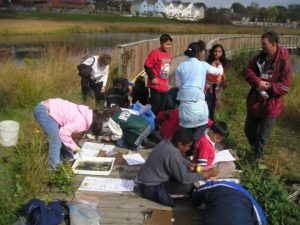
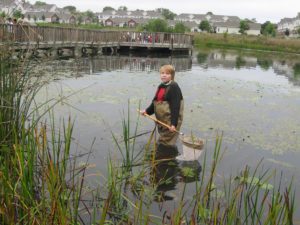
When L’Etoile du Nord moved their school to its current location at the former Ames Elementary School on White Bear Avenue, several fourth grade teachers began a ritual of walking their classes over to their lower campus by Lake Phalen to pair their fourth graders with younger students. On their weekly route, their classes would pass by Ames Lake. Several years ago, on an unusually warm, sunny winter day, fourth grade teacher Nick Gasho brought his class over to the lake to conduct a service learning project. Large stands of willow, over time had overtaken the area next to the lake, crowding out the wet meadow species. 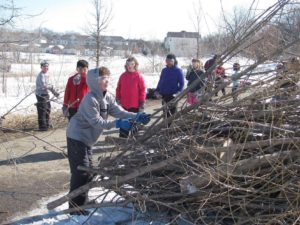 St. Paul crews had cut down much of the willow to allow the other species to return. Megan Manhattan from St. Paul Parks and Recreation needed support bundling up and moving the brush to areas where it could be easily picked up and loaded onto trucks. It was a great way to get outdoors and work off some of that mid-winter malaise and build up a sweat!
St. Paul crews had cut down much of the willow to allow the other species to return. Megan Manhattan from St. Paul Parks and Recreation needed support bundling up and moving the brush to areas where it could be easily picked up and loaded onto trucks. It was a great way to get outdoors and work off some of that mid-winter malaise and build up a sweat!
We are learning how to work together again. The elders, the children, all the cultures in the neighborhood, the sedges, the bergamot, the frogs, the dragonflies, the geese, the herons, the egrets, the butterflies, the oaks, the water, the air, the rain, the soil and the sun will conspire to help us learn how to thrive again. Ames Lake Journal April 2000
This year I decided to switch our semi-annual water quality field trip in February from Beaver Lake to Ames Lake. Watershed District WQ staff brought their monitoring equipment out to the frozen lake and demonstrated their approach to collecting data by augering holes in the ice and using the Sonde to take readings. L’Etoile du Nord fourth graders students watched the monitoring process and recorded the data collected by watershed staff. They also performed some of their own tests including measuring water clarity, dissolved oxygen and pH. Several samples from Ames Lake were sent to the lab.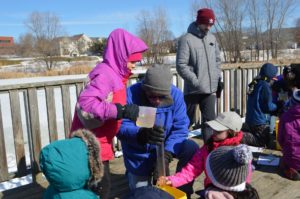
Our investigation of the water quality of Ames Lake raised some concerns when the results came back from the lab. I had been worrying about its decreasing clarity over the years, and what seemed like a diminishing diversity and prevalence of macroinvertebrates when I would collect live samples for use in classroom studies.
This was the first time since 2003 that water samples were sent into a lab. While you can’t compare winter readings with those taken in the summer, at least one parameter raised a red flag. The chloride level in the lake read high for a lake that doesn’t receive stormwater. It hit the threshold level of 232 mg/liter of chlorides which is the state standard level for impairment. While only one reading cannot tell us everything we need to know, it did raise questions in my mind and one in particular. If Ames Lake is groundwater fed, does this mean that the groundwater that feeds this lake is getting contaminated with chlorides? More study is warranted.
I’ve been in discussion with our Natural Resources Manager, Bill Bartodziej about the possibility of studying the issue of diminishing water clarity in Ames Lake. We’ve been speculating about the possibility of “introduced” species of fish such as goldfish, catfish and carp stirring up the bottom of the lake and increasing its turbidity. We’ve talked about the idea of installing box net traps to reduce the population of these non-native fish that have been introduced by birds and humans. Nothing is set yet, but more conversation about this approach for restoring clarity to the lake is warranted.
There’s another project going on behind the scenes at Ames Lake. Randee Edmundson, the educator who led the Cleveland teams when Ames Lake was restored has been working with art teacher, Aloun Phoulavan who guided the original Ames Lake students who created the bronze great blue heron sculpture that watched over Ames Lake for many years. 
They have been collaborating with several high school artists, the City of St. Paul and other partners to redesign the heron sculpture that was stolen several years ago and are producing an additional sculpture for the neighborhood. Originally anticipated for this spring, the installation and dedication for these projects near Ames Lake is slated for the fall of 2020 or the spring of 2021.
We look forward to making the announcement, like we did twenty years ago, that the Great Blue Heron is back! Watch for Randee’s story soon about this community project that has support from our watershed district, the city of St. Paul, a neighborhood developer and the District 2 planning council.
